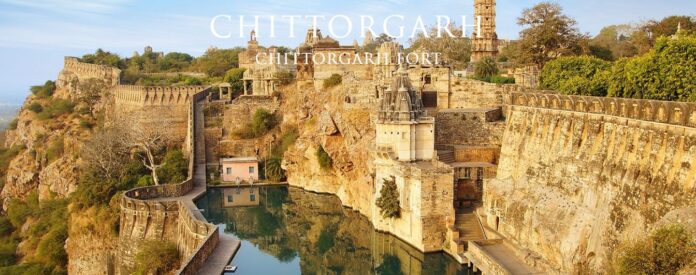By Journey Man
Chittorgarh Resonates with stories of Rajputana bravery, pride and passion. The bards of Rajasthan sing tales of courage and sacrifice recounting stories that are known to every child and adult in the city. Chittorgarh is named after its most imposing structure, the Chittorgarh Fort which stands atop a 180 meter high hill and is spread across 700 acres. Chittorgarh Fort has had a tumultuous past.
This bastion of the Rajputs has faced violent attacks thrice in its entire history. The first was in 1303 when the Sultan of Delhi, Ala-ud-din Khilji, who was enamoured by Queen Padmini, launched an attack to abduct her. More than two centuries later, in 1533, it was Bahadur Shah, the Sultan of Gujarat, who caused immense destruction. Four decades later, in 1568, Mughal Emperor Akbar attacked and seized the fort. It was finally in 1616, under the rule of Mughal Emperor Jahangir that the fort was returned to the Rajputs.
Highlights of Chittorgarh Fort: Kirti Stambh, Vijay Stambha, Padmini’s Palace, Gaumukh Reservoir, Fateh Prakash Palace, Rana Kumbha Palace, Meera Temple and annual Jauhar Mela.
Entry fees : Rs 5 per person for Indians and Rs 100 per person for foreigners.
Timings : 9:45 am to 5:15 pm
Rani Padmini’s Palace: In the context of the Chittorgarh Fort, this palace also becomes famous. It plays an important role in Rajput history. The structure is built on the banks of a lotus pool and has a pavilion that provides privacy for the women of the royal family. Ala-ud-din Khilji spotted Queen Padmini’s reflection in the pool and was so besotted by her beauty that he led his forces in battle to abduct her.
KUMBHALGARH FORT
Located 84 km north of Udaipur in the wilderness, Kumbhalgarh is the second most important citadel after Chittorgarh in the Mewar region. Cradled in the Aravalli Ranges, the fort was built in the 15th century AD by Rana Kumbha and is famous as being the birthplace of a legend, Maharana Pratap.
It is of immense sentimental significance for the people as the birthplace of Mewar’s legendary king Maharana Pratap. The fort is self-contained in all respects to withstand a protracted siege. Its defences could be breached only once by the combined armies of the Mughal and of Amer primarily for scarcity of drinking water.
Maharana Fateh Singh renovated the fort in the 19th century. The fort’s large compound has very interesting ruins and a walk around it can be very educational.


How to Reach here: Kumbhalgarh Fort is easily reached by taking either regular buses or hiring a taxi from Udaipur city. The nearest airport is in Udaipur (98 km).
Highlights of Kumbhalgarh Fort: 36 km long fortified walls, Badal Mahal, fantastic panoramic vista of locale, seven massive gateways, Jain Temple and Hindu Temple
Entry fees : Rs 10 per person for Indians; Rs 100 per person for foreigners.
Timings : 9:00 am to 6:00 pm.
RANTHAMBORE FORT
This fort signifies the glory and valour of the Chauhan Dynasty. It was built by the Chauhan rulers in the 10th century. Due to its strategic location, it was ideal to keep the enemy at bay. The fort is also related to the historical legend of the royal women performing ‘jauhar’ (self-immolation) when the Muslim invader Alauddin Khilji laid siege on this fort in 1303.
The presence of a mosque and temple within the fort precincts bears testimony to the secularity of the Rajput kings.
How to reach : Ranthambore Fort is half an hour’s drive from Sawai Madhopur town. Private taxis are available on rent.
JAISALMER FORT
Jaisalmer traces its inception to the 12th century. History tells us that Rawal Jaisal, the eldest heir of the Rawal of Deoraj, was passed over for the throne of Lodurva and a younger half-brother was crowned king. Rawal Jaisal went looking for a new location to set up his capital when he came across sage Eesul.
The sage told him about Krishna’s prophecy which said that a descendant of his Yaduvanshi clan would found a new kingdom at this same spot. It was in 1156 that Rawal Jaisal constructed a mud fort, named it Jaisalmer after himself and declared it his capital.
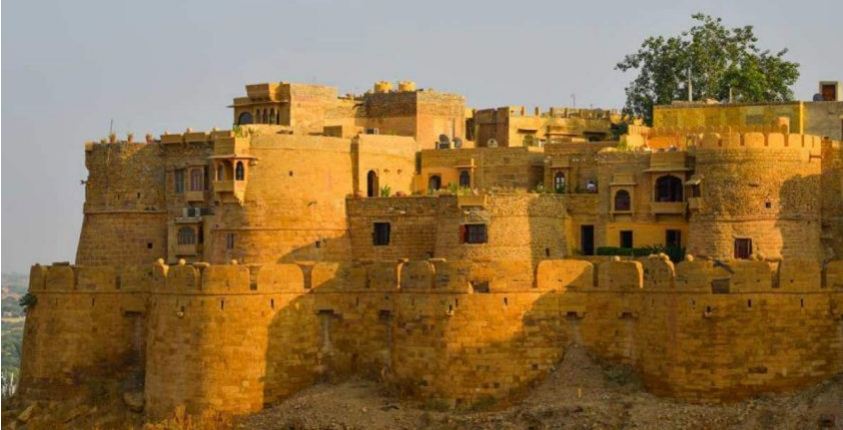

The Jaisalmer Fort also goes by the name Sonar Quila (Golden Fort) as it rises from the desert itself and seems to become one with the golden hues of the sand. The setting sun adds its own magic and shrouds the fort with mystique. The fort is constructed in the classic style of the royals by local craftsmen. This fort is a world heritage site and forms an important plot point in one of Satyajit Ray’s famous Feluda stories and corresponding movie, Sonar Kella (The Golde Fortress).
Highlights of Jaisalmer Fort : Four grand entrances, Royal Palace, Lakshminath Temple, Jaisalmer Fort Palace Museum and Heritage Centre and palaces of the merchants.
Entry fee : Entry is free for the fort. However, camera charges (Rs 50 for still and Rs 100 for video) are applicable for entering Jaisalmer Fort Palace Museum and Heritage Centre.
Timings : 9:00 am to 6:00 pm
UDAIPUR CITY PALACE
Dominating the lakescape of Udaipur, City Palace of Udaipur is among the most notable Rajasthan forts and palaces. This striking white palace complements the blue waters of Udaipur. Built by Maharana Udai Singh 1559, the City Palace boasts of having the largest palace complex in Rajasthan with a fusion of Chinese, European and Medieval architecture.
Highlights of City Palace Udaipur: Jagdish Temple, gateways, Amar Vilas, Zenana Mahal and museum Bada Mahal.
Entry fee : Rs 250 per person (Adults) and Rs 100 per person (Children).
Timings : 9:00 am to 5:00 pm
UMAID BHAWAN PALACE, JODHPUR
Initially a huge palace boasting of the historical heritage, this palace was converted into a hotel where you can now feel like a maharaja with world-class amenities. The hotel is managed by Taj Group of Hotels and boasts of 347 opulent rooms. Umaid Bhawan Palace has also well-deservingly won the World’s Best Hotel by TripAdvisor recently and it certainly is a place you cannot miss.
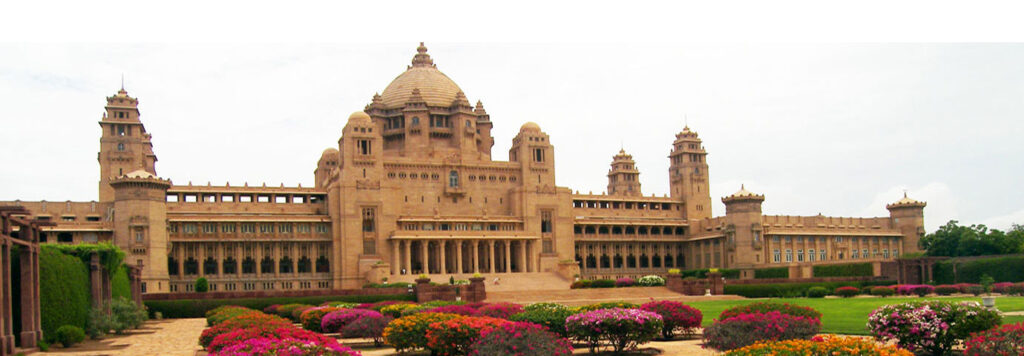

Highlights of Umaid Bhawan Palace Jodhpur : Beautiful gardens.
Entry fee : Rs 30 for Indians and Rs 100 for foreigners.
Timings : 10 AM-4:30 PM
ALWAR CITY PALACE
Also known as Vinay Vilas Palace, Alwar Palace is an epitome of the lovely blend of Indo-Islamic architecture. The palace is enveloped by Aravali Range and is among the most beautiful Rajasthan forts and palaces.
The entrance has balconies on both sides, and as you step further you’ll come across Krishna Temple on all four sides. The museum inside this 1793 palace is a treasure trove of miniature paintings and also houses armours, artefacts, coins and a silver table.
Highlights of City Palace Alwar : Museum, Moosi Rani Ki Chhatri, Durbar Hall, Krishna Temples and regal entry gates.
Entry Fee : Rs 5 per person for Indians and foreigners.
Timings : 10:00 am to 4:30 pm (except Fridays)
JUNAGARH FORT, BIKANER
Among the most immaculately crafted Rajasthan heritage forts, Junagarh deserves a special mention. This fort in Bikaner, is one of the few forts of Rajasthan which isn’t built on a ridge. Junagarh Fort, being the beauty it is and was, stole hearts of many rulers, which led to many attacks to conquer it. However, nobody won except Kamran Mirza (Son of Babar) who did it for merely a day.
Highlights of Junagarh Fort : Grand gateways, Fort Museum, Lakshmi Narayan Temple, Karan Mahal, Phool Mahal, Chandra Mahal, Ganga Mahal, Badal Mahal and Anup Mahal.
Entry fee : Rs 50 for Indians and Rs 300 for foreigners.
Timings : 10:00 am to 4:30 pm
GAGRON FORT, JHALAWAR
Sitting on a hill, in the middle of a river, Gagron Fort is a specimen of architecture that speaks of strength and displays various aspects of Rajasthani signature style. In the 12th century, it was built by Dor (Doda) Rajputs, but later, the Mughals ruled the fort for many generations. In all, the fort witnessed 14 battles and still stands strong.
Gagron Fort is also in the list of UNESCO Hill Forts of Rajasthan.
Highlights of Gagron Fort : Glistening river on three sides.
Entry fee : None
Timings : 8:00 am to 7:00 pm
AMER FORT, JAIPUR
Amer Fort is a fort cum palace that greets you with warm Rajasthani folk music and mesmerizes you with its beauty. Precision of carvings and embedment of stones prove that it is a finely-crafted marvel. Being perched on a hillock of Aravali Range, Amer Fort has been regarded as a UNESCO World Heritage Site along with other hill forts of Rajasthan.
Highlights of the fort : Elephant rides, incredible view of the city, Diwan-e-khas, Diwan-e-aam, Sukh Niwas and Sheesh Mahal.


Entry fee : Rs 100 per person for Indians and Rs 10 per person for Indian students. Foreigners have to pay Rs 500 per person and Rs 100 per person for foreign students.
Timings : 8:00 am to 6:00 pm; Light show: 7:00 pm to 9:00 pm.
A STATE WITH A COLOURFUL HISTORY
Rajasthan has seen many great rulers, and leaders. It has seen the opulence of the Rajputs, the chivalry of the Mughals, and the extravagant lifestyle of Jat rulers.
Traces of human settlement here have been found, dating back to the Indus Valley Civilization. Also, its geographic location has allowed it access to many republics like Arjunyas, Kushans, Malavas, Saka Satraps and Yaudheyas.
Rajasthan means the House of Kings or State of Kingdom. It is the largest state of India, and its location is on the country’s northwest. This is not just a state of warrior kings, but of cultural diversity and splendid architecture. Everywhere in the state you can find Valley Civilization ruins, temples, forts, and fortresses.
Rajasthan is divided into nine regions; Ajmer City, Hadoti, Dhundhar, Gorwar, Shekhawati, Mewar, Marwar, Vagad and Mewat. Each region is rich in heritage, and each has its unique history.
The Indus Valley Civilisation (3300–1500 BCE)
Kalibangan
Rajasthan was an ancient part of Indus Valley civilization (the Harappans). One of Rajasthan’s ancient cities, Hanumangarh city, was known as Kalibangan. It was said to be the capital of the Indus valley civilization. Rajasthan’s ancient civilizations provide important evidence of the earliest agricultural field ever found in Rajasthan. The Kalibangan pre-historic site was discovered by Luigi Pio Tessitori, an Italian Indologist in 1953.
Kalibangan is also identified as being established in the triangle of land at the confluence of Drishadvati and Saraswati Rivers.


Circular and triangular terracotta cakes, sling balls with pinched decoration, circular beads and spacer, terracotta, faience and shell bangles, were also found.
Baror
Baror is another pre-historic site, also discovered by Luigi Pio Tessitori, in 1916–17. Post independence, Amalananda Ghosh (Ex. Director General, Archeological Survey of India) did a detailed survey of this site. It is located in the southern part of the Sri Ganganagar district of Rajasthan, about 13 km northeast of Anupgarh, near the Pakistan border. Those circular and triangular terracotta cakes, sling balls with pinched decoration, circular beads and spacer, terracotta, faience and shell bangles, were found here as well.
Matsya Kingdom (c. 1200–345 BCE)
The Matsya Kingdom was one of the solasa (sixteen) Mahajanapadas. Painted Gray Ware culture (PGW) chiefdoms in the region were succeeded by Northern Black Polished Ware from c. 700–500 BCE, associated with the rise of the great Mahajanapada states.
It was located in central India near Kuru. It was founded by Matsya Dwaita, a son of the great emperor Uparachira Vasu.
Foreign Kingdoms ruled in Rajasthan (100–900CE)
Some foreign kingdoms ruled some parts of western and northeast Rajasthan. They faced strong opposition from indigenous kingdoms, such as the Sivi, Arjunayanas, Yaudheya and Malava. Later, these foreign kingdoms were defeated by Satavahanas and Guptas.
In 321 BCE Rajasthan was part of the Gupta Empire who built some Buddhist caves and Stupas in Jhalawar. Due to some political unrest in the 6th century, the Gupta Empire started declining. However, the situation became stable when Gujara-Pratiharas came into power in 700 CE. By 851CE the army of Gujara- Pratiharas was well settled in Rajasthan.
Medieval history
During the 9th century, the Rajput clan came to power in Rajasthan. Unparalleled in bravery, the Rajputs played a really important role in the history of Rajasthan. Rajput warriors used to fight against all the odds, lived with honour and whenever the situation demanded they sacrificed their lives for the pride of the empire. Between the eighth and twelfth centuries CE, the Rajput clan gained supremacy and were divided into 36 royal clans and 21 dynasties.
Chahamana (Chauhan) Empire (c. 650–1315 CE)
Many Rajput kings were against the Islamic rule in Rajasthan, though some of them started having bilateral talks with them. In the 10th century the Chauhan dynasty was established in Rajasthan. Under the reign of the Chauhan Empire, Rajasthan was continuously attacked by foreign rulers.


In 1191, when Rajasthan was controlled by Prithviraj Chauhan, there were constant attacks by the Muslim ruler, Muhammad Gohri resulting in the first battle of Tarain. Though Muhammad Gohri was defeated, but in 1192 he attacked for the second time, whereupon Chauhan was defeated.
After the downfall of the Chauhan clan in 1200, Muslim rulers started establishing themselves in Rajasthan.
Kingdom of Mewar (900CE–1948 CE)
There have been several dynasties within this.
Guhila dynasty (900CE–1303 CE) : The Guhila dynasty ruled the Medapata (modern Mewar) region in present-day Rajasthan state of India. In the mid-12th century, the dynasty was divided into two branches. The senior branch (whose rulers are called Rawal in the later medieval literature) ruled from Chitrakuta (modern Chittorgarh), and ended with Ratnasimha’s defeat against the Delhi Sultanate at the 1303 Siege of Chittorgarh. The junior branch ruled from Sesoda with the title Rana, and gave rise to the Sisodia Rajput dynasty.
Sisodia dynasty (1326CE–1948 CE) : The Sisodia dynasty traced its ancestry to Rahapa, a son of the 12th century Guhila king Ranasimha. The main branch of the Guhila dynasty ended with their defeat against the Khalji dynasty at the Siege of Chittorgarh (1303). In 1326, Rana Hammir, who belonged to a cadet branch of that clan, reclaimed control of the region, re-established the dynasty, and also became the originator of the Sisodia dynasty clan, a branch of the Guhila dynasty, to which every succeeding Maharana of Mewar belonged. The Sisodias regained control of the former Guhila capital Chittor.
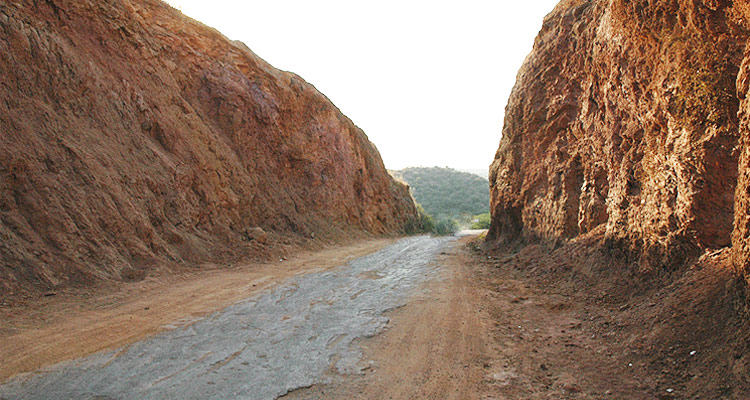

The most notable Sisodia rulers were Rana Hamir (1326–64), Rana Kumbha (1433–68), Rana Sanga (1508–1528) and Rana Pratap (1572–97). The Bhonsle clan, to which the Maratha empire’s founder Shivaji belonged, also claimed descent from a branch of the royal Sisodia family. Similarly, the Rana dynasty of Nepal also claimed descent from the Ranas of Mewar.
Bhati dynasty of Jaisalmer (600–1949 CE) : Bhati comes from Bhatner. The Maharajas of Jaisalmer trace their lineage back to Jaisimha, a ruler of a Bhati clan, through Deoraj, a famous prince of the Yaduvanshi Bhati, Rajput ruler during the 9th century. With him the title of Rawal commenced. Rawal means “of the Royal house”
Amer dynasty : Amer, the capital of the kingdom, was founded by the Meena king Ralun Singh, but was captured during his lifetime by the Kachwaha Rajputs. As Mughal Emperor Akbar took on the might of the Rajputs, Raja Bharmal gave his daughter to Akbar and sets the precedent. Akbar inducted Raja Bharmal’s son, Bhagwandas, and grandson, Man Singh, into his body of high ranking courtiers. Maharana Uday Singh of Mewar refused the offer. Maharaja Sawai Pratap Singh built Hawa Mahal in 1799.
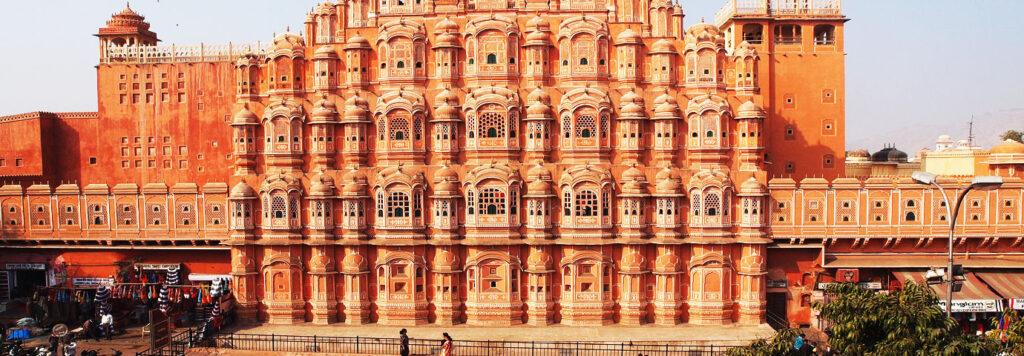

Mughal Interference : Mughal Emperor Akbar expanded the empire into Rajputana in the 16th century CE. He laid siege to Chittor and defeated the Kingdom of Mewar in 1568. He also laid siege to Ranthambore and defeated the forces of Surjan Hada in the same year. Akbar also arranged matrimonial alliances to gain the trust of Rajput rulers.
He himself married the Rajput princess Jodha Bai. He also granted high offices to a large number of Rajput princes, and maintained cordial relations with them, such as Man Singh, one of the navaratnas.
However, some Rajput rulers were not ready to accept Akbar’s dominance and preferred to remain independent. Two such rulers were Udai Singh of Mewar and Chandrasen Rathore of Marwar. They did not accept Akbar’s supremacy and were at constant war with him.
This struggle was continued by Rana Pratap, the successor of Udai Singh. His army met with Akbar’s forces at the Battle of Haldighati where he was defeated and wounded. Since then he remained in recluse for twelve years and attacked the Mughals from time to time.
Mughal influence is seen in the styles of Rajput painting and Rajput architecture of the medieval period.
Maratha Interference (1720 CE–1817 CE) : Since the early 1700s, the Maratha Empire began expanding northwards, led by Peshwa Baji Rao I of Pune. This expansion finally brought the newly founded Maratha Empire in contact with the Rajputs. Rajasthan saw many invasions by the Marathas, under military leadership of Holkars and Scindhias.
British Colonial Period (1817–1948 CE) : The arrival of the British East India Company in the region led to the administrative designation of some geographically, culturally, economically and historically diverse areas, which had never shared a common political identity, under the name of the Rajputana Agency. This was a significant identifier, being modified later to Rajputana Province and lasting until the renaming to Rajasthan in 1949.
In 1818, the Rawals of Jaisalmer State signed a treaty with the British, and was guaranteed royal succession. Jaisalmer was one of the last Rajput states to sign a treaty with the British. Jaisalmer was forced to invoke the provisions of the treaty and call on the services of the British in 1829 to avert a war with Bikaner and 10 years later in 1839 for the First Anglo-Afghan War.
In 1817–18, the British Government concluded treaties of alliance with almost all the states of Rajputana. Thus began the British rule over Rajasthan, then called Rajputana.
Modern history
In March 1948 the Matsya Union, consisting of Alwar, Bharatpur, Dholpur and Karauli, was formed. Also, in March 1948 Banswara, Bundi, Dungarpur, Jhalawar, Kishangarh, Kota, Pratapgarh, Shahpura and Tonk joined the Indian Union and formed a part of Rajasthan. In April 1948 Udaipur joined the state and the Maharana of Udaipur was made Rajpramukh. Therefore, in 1948 the merger of south and southeastern states was almost complete.
On January 26, 1950, 18 states of united Rajasthan merged with Sirohi to join the state leaving Abu and Dilwara to remain a part of Greater Bombay and now Gujarat. Hiralal Shastri was the first nominated chief minister of the state, taking office on April 7, 1949.
The princes of the former kingdoms were constitutionally granted handsome remuneration in the form of privy purses and privileges to assist them in the discharge of their financial obligations.
In 1971 Prime Minister Indira Gandhi abolished the privy purses. Many of the former princes still continue to use the title of Maharaja, but the title has little power other than as a status symbol. Many of the Maharajas still hold their palaces and have converted them into profitable hotels, while some have made good in politics.

